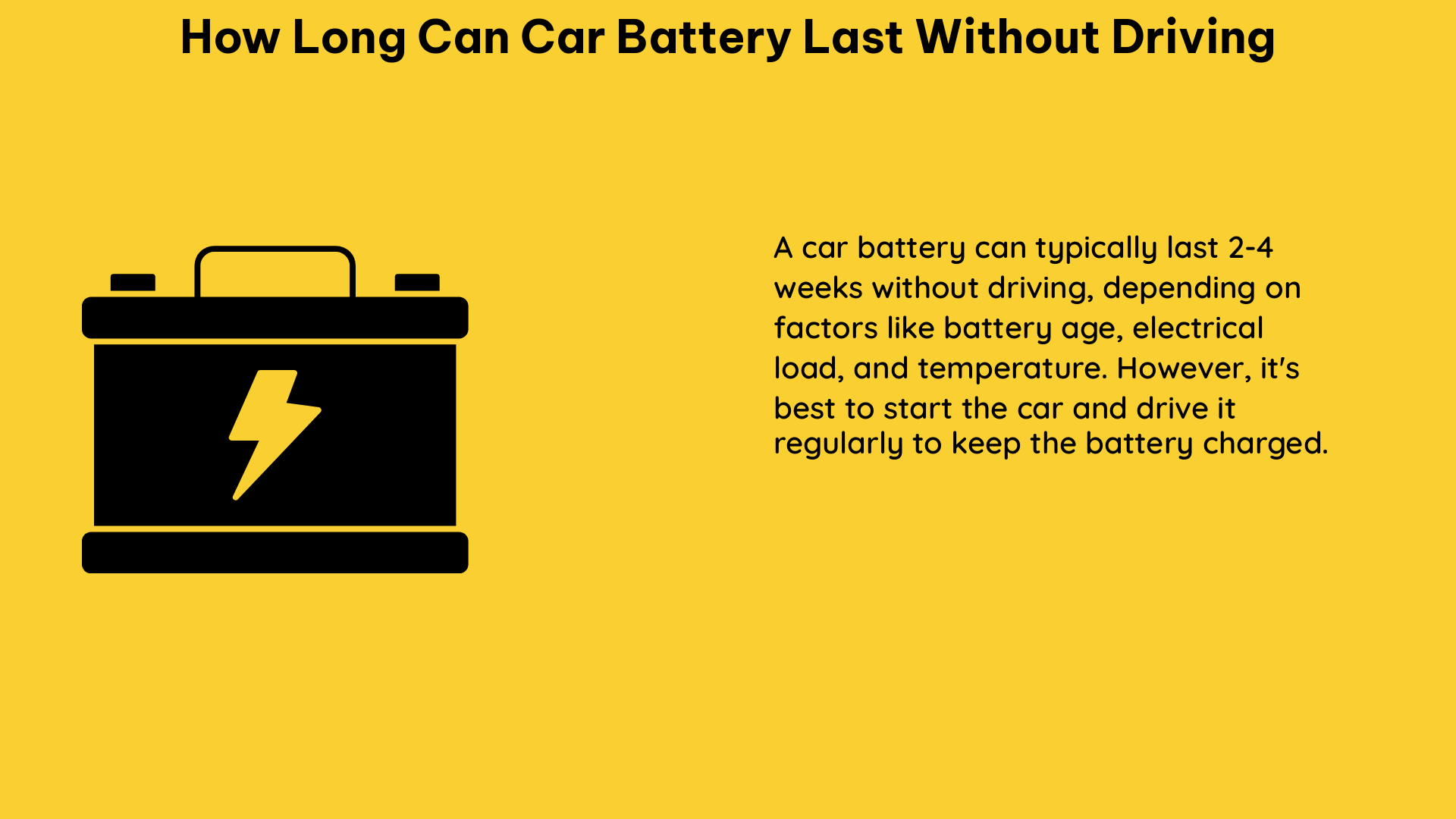A car battery is a crucial component that powers the electrical systems and starts the engine of a vehicle. When a car is not driven for an extended period, the battery can gradually lose its charge, leading to potential issues. Understanding the factors that influence a car battery’s lifespan when the vehicle is not in use is essential for maintaining its performance and ensuring a smooth driving experience.
Factors Affecting Car Battery Life Without Driving
Battery Capacity and Age
The capacity and age of a car battery are significant factors in determining how long it can last without driving. A new, high-quality car battery typically has a capacity of around 48-60 Ah (Ampere-hours), which can provide up to 2 weeks of standby power before needing a recharge. However, as the battery ages, its capacity and ability to hold a charge diminish, reducing the time it can last without driving.
Electrical Load and Parasitic Drain
Even when a car is not in use, the battery continues to power various electrical components, such as the clock, alarm system, and other accessories. This constant power draw, known as parasitic drain, can gradually deplete the battery’s charge over time. The amount of electrical load on the battery can vary depending on the specific make and model of the vehicle, as well as the number of electrical components installed.
Temperature Conditions
The ambient temperature can also impact a car battery’s lifespan when the vehicle is not driven. Extreme temperatures, both hot and cold, can accelerate the battery’s self-discharge rate and reduce its overall lifespan. In hot climates, the battery’s internal chemical reactions can occur at a faster rate, leading to a quicker loss of charge. Conversely, in cold weather, the battery’s ability to hold a charge and deliver power can be diminished.
Battery Maintenance and Charging
Proper battery maintenance and regular charging can significantly extend the time a car battery can last without driving. Regularly starting the engine and letting it run for at least 15 minutes once a week can help recharge the battery and prevent it from becoming completely discharged. Additionally, using a battery maintainer or trickle charger can help keep the battery at an optimal charge level during extended periods of inactivity.
Estimating Car Battery Life Without Driving

Based on the factors mentioned above, here’s a general estimate of how long a car battery can last without driving:
| Battery Condition | Estimated Lifespan Without Driving |
|---|---|
| New, high-quality battery | 2-3 weeks |
| Moderately used battery (1-2 years old) | 1-2 weeks |
| Older battery (3+ years old) | 5-10 days |
It’s important to note that these estimates are based on average conditions and may vary depending on the specific make, model, and usage patterns of the vehicle. Factors such as the electrical load, temperature, and battery maintenance practices can significantly impact the actual lifespan of the battery.
Recharging a Flat or Dead Battery
If a car battery becomes completely discharged due to prolonged inactivity, there are a few methods to recharge it:
-
Battery Removal and Storage: The battery can be removed from the vehicle and stored in a dry, temperature-controlled environment (between 40°F and 60°F) for 6 weeks to 6 months. However, it is recommended to recharge the battery before the 3-month mark to ensure its proper functioning.
-
Battery Maintainer or Trickle Charger: Using a battery maintainer or trickle charger can help keep the battery at an optimal charge level and prevent it from becoming completely discharged during extended periods of inactivity. These devices automatically monitor the battery’s charge and provide a gentle, continuous charge to maintain its health.
-
Jump-starting the Battery: If the battery is completely flat, it can be jump-started using another vehicle or a portable jump starter. This method should be used with caution and in accordance with the manufacturer’s instructions to avoid potential damage to the electrical system.
It’s important to note that if a car battery has been left completely discharged for an extended period, it may have suffered permanent damage and may need to be replaced, even after recharging.
Conclusion
In summary, a car battery can typically last 2-3 weeks without driving, depending on its condition, age, and the electrical load on the battery. Regular maintenance, such as starting the engine for 15 minutes once a week and using a battery maintainer, can help extend the battery’s lifespan during periods of inactivity. If the battery becomes flat or dead, it can be recharged by removing it and storing it properly or using a battery maintainer. By understanding the factors that affect a car battery’s lifespan without driving, you can take proactive steps to ensure your vehicle’s electrical system remains in optimal condition, even during extended periods of inactivity.
Reference:
– How Long Can a Car Battery Last Without Driving?
– How Long Does a Car Battery Last Without Driving It?
– How Long Do Car Batteries Usually Last?

The lambdageeks.com Core SME Team is a group of experienced subject matter experts from diverse scientific and technical fields including Physics, Chemistry, Technology,Electronics & Electrical Engineering, Automotive, Mechanical Engineering. Our team collaborates to create high-quality, well-researched articles on a wide range of science and technology topics for the lambdageeks.com website.
All Our Senior SME are having more than 7 Years of experience in the respective fields . They are either Working Industry Professionals or assocaited With different Universities. Refer Our Authors Page to get to know About our Core SMEs.